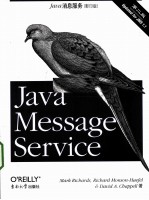

Java消息服务 影印版PDF电子书下载
- 电子书积分:12 积分如何计算积分?
- 作 者:MarkRichards,RichardMonson-Haefel著
- 出 版 社:南京:东南大学出版社
- 出版年份:2010
- ISBN:9787564119300
- 页数:307 页
1.Messaging Basics 1
The Advantages of Messaging 3
Heterogeneous Integration 3
Reduce System Bottlenecks 3
Increase Scalability 4
Increase End User Productivity 4
Architecture Flexibility and Agility 5
Enterprise Messaging 5
Centralized Architectures 7
Decentralized Architectures 7
Hybrid Architectures 8
Centralized Architecture As a Model 8
Messaging Models 9
Point-to-Point 10
Publish-and-Subscribe 10
JMS API 11
Point-to-Point API 13
Publish-and-Subscribe API 14
Real-World Scenarios 14
Service-Oriented Architecture 15
Event-Driven Architecture 16
Heterogeneous Platform Integration 16
Enterprise Application Integration 17
Business-to-Business 17
Geographic Dispersion 18
Information Broadcasting 18
Building Dynamic Systems 18
RPC Versus Asynchronous Messaging 21
Tightly Coupled RPC 21
Enterprise Messaging 23
2.Developing a Simple Example 25
The Chat Application 25
Getting Started with the Chat Example 28
Examining the Source Code 30
Sessions and Threading 39
3.Anatomy of a JMS Message 41
Headers 42
Automatically Assigned Headers 43
Developer-Assigned Headers 46
Properties 47
Application-Specific Properties 47
JMS-Defined Properties 49
Provider-Specific Properties 50
Message Types 50
Message 50
TextMessage 51
ObjectMessage 52
BytesMessage 53
StreamMessage 56
MapMessage 58
Read-Only Messages 60
Client-Acknowledged Messages 61
Interoperability and Portability of Messages 61
4.Point-to-Point Messaging 63
Point-to-Point Overview 63
When to Use Point-to-Point Messaging 66
The QBorrower and QLender Application 67
Configuring and Running the Application 67
The QBorrower Class 69
The QLender Class 76
Message Correlation 81
Dynamic Versus Administered Queues 83
Load Balancing Using Multiple Receivers 84
Examining a Queue 85
5.Publish-and-Subscribe Messaging 87
Publish-and-Subscribe Overview 87
When to Use Publish-and-Subscribe Messaging 89
The TBorrower and TLender Application 90
Configuring and Running the Application 90
The TLender Class 92
The TBorrower Class 96
Durable Versus Nondurable Subscribers 100
Dynamic Versus Administered Subscribers 101
Unsubscribing Dynamic Durable Subscribers 104
Temporary Topics 104
6.Message Filtering 107
Message Selectors 109
Identifiers 110
Literals 111
Comparison Operators 111
Arithmetic Operators 113
Declaring a Message Selector 114
Message Selector Examples 116
Managing Claims in an HMO 116
Notification of Certain Bids on Inventory 116
Priority Handling 116
Stock Trade Order Auditing 117
Not Delivered Semantics 117
Design Considerations 118
7.Guaranteed Messaging and Transactions 125
Guaranteed Messaging 125
Message Autonomy 126
Store-and-Forward Messaging 126
Message Acknowledgments and Failure Conditions 126
Message Acknowledgments 127
AUTO_ACKNOWLEDGE 127
DUPS_OK_ACKNOWLEDGE 132
CLIENT_ACKNOWLEDGE 132
Message Groups and Acknowledgment 133
Handling Redelivery of Messages in an Application 134
Message Groups Example 134
Message Grouping and Multiple Receivers 143
Transacted Messages 145
Creating and Using a JMS Transaction 147
Transacted Session Example 147
Distributed Transactions 150
Lost Connections 151
The ExceptionListener Example 152
Dead Message Queues 153
8.Java EE and Message-Driven Beans 155
Java EE Overview 155
Enterprise JavaBeans 156
Enterprise JavaBeans 3.0(EJB3)Overview 157
Simplified Bean Development 158
Dependency Injection 158
Simplified Callback Methods 159
Programmatic Defaults 159
Interceptors 160
Java Persistence API 162
JMS Resources in Java EE 162
The JNDI Environment Naming Context(ENC) 164
Message-Driven Beans 166
Concurrent Processing and Scalability 168
Defining Message-Driven Beans 168
Message-Driven Bean Use Cases 171
Message Facade 171
Transformation and Routing 173
9.Spring and JMS 177
Spring Messaging Architecture 177
JmsTemplate Overview 180
Send Methods 181
convertAndSend Methods 181
receive and receiveSelected Methods 182
receiveAndConvert Methods 183
Connection Factories and JMS Destinations 184
Using JNDI 184
Using Native Classes 187
Sending Messages 189
Using the send Method 190
Using the convertAndSend Method 191
Using a Nondefault JMS Destination 193
Receiving Messages Synchronously 195
Message-Driven POJOs 198
The Spring Message Listener Container 198
MDP Option 1:Using the MessageListener Interface 199
MDP Option 2:Using the SessionAwareMessageListener Interface 201
MDP Option 3:Using the MessageListenerAdapter 202
Message Conversion Limitations 207
The Spring JMS Namespace 208
<jms:listener-container>Element Properties 209
<jms:listener>Element Properties 211
10.Deployment Considerations 213
Performance,Scalability,and Reliability 213
Determining Message Throughput Requirements 213
Testing the Real-World Scenario 214
To Multicast or Not to Multicast 217
TCP/IP 218
UDP 218
IP Multicast 218
Messaging Over IP Multicast 219
The Bottom Line 221
Security 222
Authentication 222
Authorization 223
Secure Communication 224
Firewalls and HTTP Tunneling 224
Connecting to the Outside World 225
Bridging to Other Messaging Systems 227
11.Messaging Design Considerations 229
Internal Versus External Destination 229
Internal Destination Topology 230
External Destination Topology 231
Request/Reply Messaging Design 232
Messaging Design Anti-Patterns 236
Single-Purpose Queue 236
Message Priority Overuse 240
Message Header Misuse 240
A.The Java Message Service API 245
B.Message Headers 265
C.Message Properties 277
D.Installing and Configuring ActiveMQ 285
Index 291
- 《情报学 服务国家安全与发展的现代情报理论》赵冰峰著 2018
- 《中央财政支持提升专业服务产业发展能力项目水利工程专业课程建设成果 设施农业工程技术》赵英编 2018
- 《体育公共服务改革 理想之美与现实之殇》齐超 2019
- 《会议服务》黄程主编 2015
- 《创新的脚步 全国社区治理和服务创新实验区成果集萃》民政部编写组编著 2018
- 《微笑 影印本》N.达列基作 1947
- 《大数据环境下的信息管理方法技术与服务创新丛书 俄罗斯档案事业改革与发展研究》徐胡乡责编;肖秋会 2019
- 《服务英语》姜宇彤 2018
- 《金丝髪 侦探小说 影印本》格离痕著 1914
- 《以患者为中心的医疗服务与管理》梁海伦著 2019
